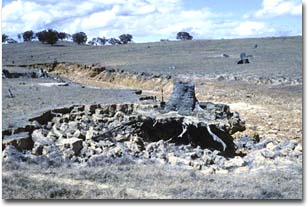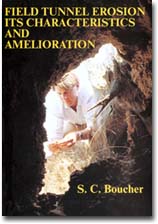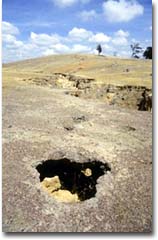Tunnel Erosion
Land degradation | Water erosion
Distribution of Tunnel Erosion | Tunnel Initiation & Development | Reclamation of Tunnelled Land | Conclusions | References
S.C. Boucher
School of Geography and
Environmental Science
Monash University, Victoria 3800
This section has been reviewed by Dr. Ian Sargeant.
Further information can be found in the monograph entitled Field Tunnel Erosion - Its Characteristics and Amelioration by Stuart Boucher. This publication can be obtained by contacting the Publications Secretary, School of Geography and Environmental Science, PO Box 11A, Monash University, Victoria 3800 (Telephone: 03 9905 2929).
| Introduction Rill, gully and tunnel erosion are types of water erosion in which storm runoff is conducted through channels (Rose, 1993). The work of Fitzpatrick et al. (1994) provided the following definitions. Rills are narrow open channels less than 30 cm in depth which often occur on agricultural land and can be obliterated by cultivation. The dimensions of these features tend to increase in response to successive runoff-producing storms and may eventually become gullies. A gully is an open channel which is often steep-sided, `U' or `V'-shaped in cross-section, bare of vegetation and of sufficient depth that it cannot be traversed by agricultural machinery. However, piping or tunnel erosion as it is known in Australia, is an insidious and enigmatic process involving the hydraulic removal of subsurface soil, causing the formation of underground passageways (ie. tunnels) in landscapes. Ingles (1968) made a distinction between the latter two terms regarding processes of earthwork failure, although they are used synonymously in many countries (Boucher, 1990). A gully remains when relatively long sections of the surface soil collapse into the tunnel. Tunnel erosion is a complex land management problem owing to difficulties in locating the site(s) of tunnel initiation, the variety of initiation mechanisms, and the often nonsaline-sodic and highly erodible nature of the B horizon clays in which these channels frequently form. The environmental consequences of tunnelling include injury to livestock and damage to farm equipment when the surface soil gives way, as well as reduced trafficability and diminished amenity of the affected land. Rabbits can inhabit tunnels and this increases the grazing pressure on adjacent land. The spontaneous dispersion of clay particles, especially from the subsoil may also produce off-site effects such as the enhanced sedimentation of reservoirs.  The dispersive clay subsoil has been eroded, undermining the surface soil and leaving the roots of a tree stump exposed near Costerfield. Photograph: Stuart Boucher. |  |
 A tunnel-eroded landscape near Costerfield, north-central Victoria. Note the large number of tree stumps which remain following deforestation and the subcatchment gully into which many tunnels drain. Photograph: Tony Miller. |


